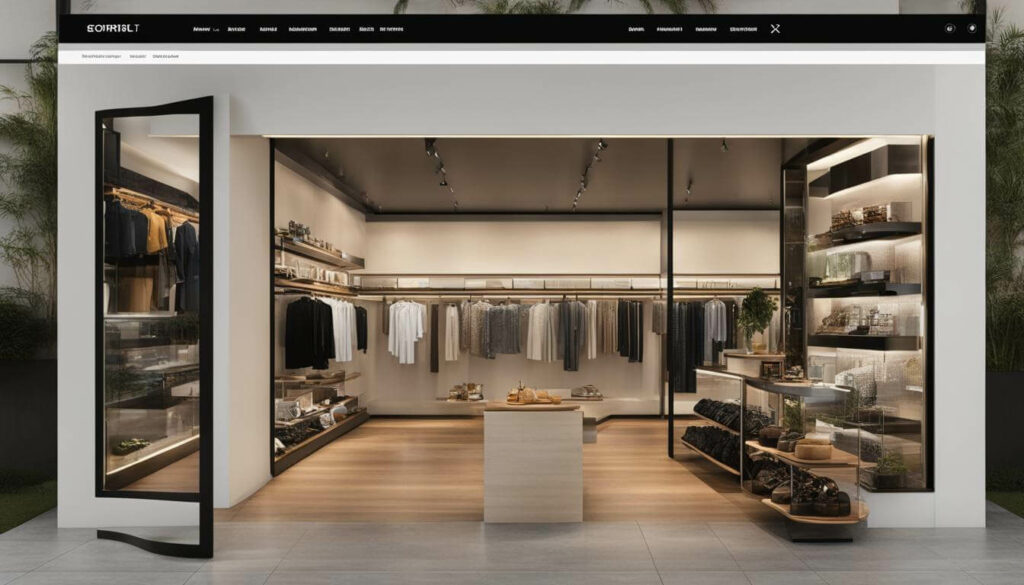Merchandising plays a critical role in the success of ecommerce businesses. The way products are presented and marketed online can greatly influence consumer behavior and drive sales. This is where the concept of visual appeal comes into play. A visually appealing ecommerce website can captivate customers, engage them with the products, and ultimately convert them into buyers.
Merchandising in ecommerce terminology goes beyond simple product displays. It encompasses strategies and techniques that aim to optimize the online shopping experience. From eye-catching product images to personalized recommendations, every aspect of merchandising is designed to create a seamless and enticing customer journey.
Merchandising
Ecommerce merchandising refers to the strategic approach of presenting and promoting products on an online store. It involves product categorization, visual display, personalized recommendations, and promotional tactics to enhance the shopping experience, influence purchasing decisions, and increase overall customer satisfaction. Ecommerce merchandising is an essential consideration for any ecommerce site, as it enables online stores to guide shoppers through their customer journey, boost sales, and establish a loyal customer base. Effective ecommerce merchandising involves understanding customer behavior, tracking customer movements around the website, and leveraging those insights to create personalized and relevant product recommendations.
Let’s explore the evolution of merchandising and its significance in ecommerce. We will dive into the basics of ecommerce merchandising, including the power of visual appeal and the impact of personalization. Additionally, we will discuss the importance of merchandising for ecommerce businesses, highlighting how it can enhance customer engagement and solidify brand image.
Furthermore, we will delve into the influencing factors that affect merchandising strategies and look at strategies to improve overall merchandising effectiveness. This includes optimizing product pages, pricing strategies, and providing a top-notch user experience. Finally, we will examine how data analytics and customer insights can be leveraged to measure and analyze merchandising success, as well as the challenges and considerations involved.

Key Takeaways:
- Merchandising in ecommerce plays a crucial role in driving sales and influencing consumer behavior.
- Visual appeal is a key component of ecommerce merchandising, captivating customers and enhancing the online shopping experience.
- Merchandising helps ecommerce businesses engage customers, promote a variety of products, and convert browsers into buyers.
- Market trends, customer preferences, and pricing strategies are among the influencing factors that shape merchandising strategies.
- Data analytics and customer insights are important tools for measuring and improving merchandising effectiveness.
Understanding the Basics of Ecommerce Merchandising
In the ever-evolving world of ecommerce, merchandising plays a crucial role in driving online sales and shaping consumer behavior. In this section, we will explore the fundamental aspects of ecommerce merchandising and its impact on the online shopping experience. From its humble beginnings to the power of visual appeal and personalization, we will uncover the strategies that have revolutionized the way we present products to customers.
The Evolution of Ecommerce Merchandising
When ecommerce first emerged, merchandising focused primarily on product listings and descriptions, with little emphasis on the visual component. Online shoppers were more forgiving as they were not equipped with high expectations for a visually appealing online shopping experience.
However, as technology advanced and consumer expectations grew, merchandising strategies began to evolve. Retailers realized the critical role that visuals play in capturing attention, evoking emotions, and influencing buying decisions. The online shopping experience transformed into a visually immersive journey, where captivating imagery and compelling product presentations became the new norm.
Today, consumers crave an engaging and immersive online shopping experience. They expect to be visually stimulated and inspired, experiencing products in a way that closely mimics the physical retail environment. In response, ecommerce businesses have embraced merchandising strategies that leverage stunning visuals to enhance the online shopping experience and drive sales.
The Power of Visual Appeal and Consumer Behavior
Visual appeal is a powerful tool in ecommerce merchandising that influences consumer behavior and purchase decisions. A well-curated product page with high-quality images, detailed descriptions, and interactive visual elements can captivate customers and encourage them to explore more. The strategic placement of visually appealing content can create a seamless and enticing shopping experience, leading to increased online sales.
Research has shown that consumers are more likely to engage with products that are visually appealing and provide an immersive experience. They spend more time on websites with eye-catching visuals and are more likely to make a purchase when visually stimulated. Therefore, ecommerce businesses must prioritize the visual presentation of their products to create a lasting impression on potential customers and drive conversions.
Personalization in Visual Merchandising
Personalization is another essential element of ecommerce merchandising that contributes to the overall online shopping experience. While visually captivating content is crucial, striking the right balance between personalization and exploration is equally important.
Providing personalized recommendations based on customer browsing history, preferences, and demographics can enhance the shopping experience and make customers feel understood and valued. However, striking a balance is vital to avoid overwhelming customers with highly personalized content, limiting their exploration of new products and potentially hindering sales.
By incorporating smart personalization techniques, ecommerce businesses can create a personalized visual merchandising experience that guides customers while still leaving room for exploration and discovery.

The Significance of Merchandising to Ecommerce Businesses
In this section, we will explore the significance of merchandising for ecommerce businesses. Ecommerce merchandising plays a crucial role in driving online sales, engaging customers, shaping brand image, and understanding consumer behavior.
Enticing Customers and Showcasing Products
Effective merchandising techniques entice customers to explore and make purchases on ecommerce websites. By strategically arranging and promoting products, businesses can create an appealing online shopping experience that encourages visitors to stay and make a purchase. Captivating visuals, such as high-quality product images, videos, and compelling product descriptions, help showcase the variety of products available and provide customers with the information they need to make informed purchasing decisions.
Benefits of Ecommerce MerchandisingExamplesGenerates website trafficBy optimizing product listings and incorporating relevant keywords, businesses can improve their search engine rankings and attract more visitors to their website.Promotes specific products or offersHighlighting featured products, limited-time promotions, or discounts can increase customer interest and drive sales for specific items.Converts browsers into buyersThrough effective merchandising, businesses can create a seamless and intuitive shopping experience that guides customers through the purchase process, increasing conversion rates.
By implementing these merchandising strategies, ecommerce businesses can improve customer engagement, increase online sales, and ultimately drive revenue growth.
Building Brand Image and Consumer Behavior
Merchandising plays a pivotal role in shaping and solidifying the brand image of an ecommerce business. The way products are presented and marketed online reflects the values, identity, and reputation of the brand. A cohesive and visually appealing merchandising strategy helps create a positive and memorable brand experience for customers, fostering brand loyalty and advocacy.
Furthermore, merchandising techniques can influence consumer behavior. By strategically placing related products together, suggesting complementary items, or showcasing customer reviews and testimonials, businesses can incentivize customers to make additional purchases or explore new product categories, increasing average order values and customer lifetime value.
Effective merchandising creates a seamless and intuitive shopping experience that guides customers through the purchase process, increasing conversion rates.
In conclusion, merchandising is essential for ecommerce businesses to drive online sales, engage customers, shape brand image, and influence consumer behavior. By employing a thoughtful merchandising strategy and leveraging visual appeal, businesses can create a compelling online shopping experience that captures customer attention, promotes products, and ultimately leads to increased conversions and customer satisfaction.

Influencing Factors and Strategies to Improve Merchandising
Merchandising strategies in ecommerce are strongly influenced by market trends, customer preferences, product placement, pricing strategy, and user experience. It is essential for merchandisers to analyze these factors to curate a product assortment that aligns with customer needs and maximizes sales potential.
Market Trends
Staying informed about current market trends is crucial for effective merchandising. By studying market trends, ecommerce businesses can identify emerging product categories, understand consumer demand, and make informed decisions about their product assortment. This allows them to stay ahead of the competition and offer products that are in high demand.
Customer Preferences
Understanding customer preferences is key to successful merchandising. By analyzing customer data and conducting market research, ecommerce businesses can gain insights into what their target audience wants. This includes factors such as preferred product features, colors, sizes, and styles. By aligning their product assortment with customer preferences, businesses can enhance customer satisfaction and drive sales.
Product Placement
The strategic placement of products on an ecommerce website can greatly impact sales. By organizing products in a logical and intuitive manner, businesses can enhance the user experience and make it easier for customers to find what they are looking for. Additionally, featuring popular or discounted products prominently can help increase their visibility and boost sales.
Pricing Strategy
Pricing plays a crucial role in merchandising decisions. Ecommerce businesses need to consider factors such as competition, production costs, and customer perception when determining their pricing strategy. By offering competitive prices that reflect the value of their products, businesses can attract customers and encourage repeat purchases. Moreover, promotional pricing strategies, such as discounts and limited-time offers, can create a sense of urgency and drive sales.
User Experience
The user experience on an ecommerce website is vital to successful merchandising. A seamless and intuitive browsing experience can greatly influence customer satisfaction and encourage conversions. This includes factors such as fast page loading times, easy navigation, and clear product information. By optimizing the user experience, businesses can create a positive shopping environment that increases customer engagement and sales.

StrategyDescriptionOptimizing Product PagesBy enhancing product pages with high-quality images, detailed descriptions, and customer reviews, businesses can provide customers with the information they need to make informed purchasing decisions. This helps build trust and increases the likelihood of sales.Implementing Personalization TechniquesPersonalization techniques, such as product recommendations based on browsing history or previous purchases, can enhance the user experience and increase customer satisfaction. By tailoring the shopping experience to individual preferences, businesses can drive repeat purchases and customer loyalty.Providing a Seamless User ExperienceA seamless user experience involves ensuring fast loading times, easy navigation, and mobile optimization. This allows customers to browse and complete purchases effortlessly, resulting in a positive impression of the brand and increased likelihood of future sales.Creating Compelling PromotionsWell-designed promotions, such as limited-time offers, discounts, or exclusive deals, can generate excitement and incentivize customers to make a purchase. By creating a sense of urgency, businesses can drive sales and boost revenue.
Measuring and Analyzing Merchandising Success, Challenges, and Considerations
In order to ensure the effectiveness of your ecommerce merchandising efforts, it is crucial to measure and analyze your success. By utilizing data analytics and gaining valuable customer insights, you can better understand consumer behavior and make informed decisions to improve your merchandising strategies.
One important aspect to consider is inventory management. By effectively managing your inventory, you can ensure that popular products are always in stock, minimizing the chances of lost sales and dissatisfied customers. Additionally, implementing A/B testing allows you to experiment with different merchandising techniques and identify the most effective strategies for driving sales.
However, it is important to acknowledge the challenges that come with ecommerce merchandising. With the vast amount of data available, it can be overwhelming to analyze and extract meaningful insights. It requires expertise in data analytics tools and a deep understanding of consumer behavior to make accurate interpretations. Additionally, the ever-changing landscape of ecommerce requires vigilance in staying up-to-date with the latest trends and customer preferences.
To overcome these challenges, it is recommended to invest in a robust data analytics platform that can consolidate, analyze, and visualize your data effectively. By gaining valuable customer insights, you can make informed decisions regarding product placement, pricing strategies, and personalized recommendations. Staying proactive and engaging in continuous learning about the latest trends and consumer preferences will also help you stay ahead of the competition and drive success in ecommerce merchandising.
Source Links
- https://www.bigcommerce.com/blog/ecommerce-merchandising-strategies/
- https://simtechdev.com/blog/ecommerce-merchandising/
- https://www.fastsimon.com/a/articles/evolution-of-merchandising-how-visual-appeal-drives-online-sales
FAQs
What is merchandising in ecommerce?
Merchandising in ecommerce refers to the strategic process of presenting and marketing products online to attract customers and drive sales. It involves curating product assortments, optimizing product pages, and using visual appeal to create an engaging online shopping experience.
How does visual appeal help drive online sales?
Visual appeal plays a crucial role in capturing the attention of online shoppers and influencing their purchasing decisions. High-quality images, captivating product displays, and attractive website design can enhance the perceived value of products and create a positive impression, ultimately leading to higher conversion rates and increased online sales.
Why is merchandising important for ecommerce businesses?
Merchandising is vital for ecommerce businesses as it enables them to entice customers, showcase a variety of products, generate website traffic, promote specific offers or products, and convert browsing shoppers into buyers. Effective merchandising helps establish a strong brand image, enhances customer engagement, and boosts sales.
What factors influence merchandising strategies?
Merchandising strategies are influenced by market trends, customer preferences, product placement, pricing strategy, and the overall user experience. Merchandisers analyze these factors to create a curated product assortment, optimize product pages with compelling visuals and detailed descriptions, and provide a seamless online shopping experience.
How can merchandising success be measured and analyzed?
Merchandising success can be measured and analyzed using data analytics and customer insights. These tools help understand consumer behavior, track sales performance, and identify areas for improvement. Inventory management techniques, A/B testing, and monitoring key performance indicators (KPIs) are also essential in assessing and optimizing merchandising efforts.
What are the challenges and considerations in ecommerce merchandising?
Ecommerce merchandising faces challenges such as managing inventory, maintaining consistent branding across channels, and keeping up with evolving consumer expectations. It requires careful attention to pricing strategies, competitor analysis, and adapting to changing market trends. By staying updated, leveraging data, and continuously optimizing merchandising efforts, these challenges can be effectively overcome.


